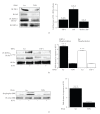Glucose regulation of thrombospondin and its role in the modulation of smooth muscle cell proliferation
- PMID: 20689700
- PMCID: PMC2905704
- DOI: 10.1155/2010/617052
Glucose regulation of thrombospondin and its role in the modulation of smooth muscle cell proliferation
Abstract
Smooth muscle cells (SMC) maintained in high glucose are more responsive to IGF-I than those in normal glucose. There is significantly more thrombospondin-1 (TSP-1) in extracellular matrix surrounding SMC grown in 25 mM glucose. In this study we investigated 1) the mechanism by which glucose regulates TSP-1 levels and 2) the mechanism by which TS-1 enhances IGF-I signaling. The addition of TSP-1 to primary SMC was sufficient to enhance IGF-I responsiveness in normal glucose. Reducing TSP-1 protein levels inhibited IGF-I signaling in SMC maintained in high glucose. We determined that TSP-1 protected IAP/CD47 from cleavage and thereby facilitated its association with SHP substrate-1 (SHPS-1). We have shown previously that the hyperglycemia induced protection of IAP from cleavage is an important component of the ability of hyperglycemia to enhance IGF-I signaling. Furthermore we determined that TSP-1 also enhanced phosphorylation of the beta3 subunit of the alphaVbeta3 integrin, another molecular event that we have shown are critical for SMC response to IGF-I in high glucose. Our studies also revealed that the difference in the amount of TSP-1 in the two different glucose conditions was due, at least in part, to a difference in the cellular uptake and degradation of TSP-1.
Figures







Similar articles
-
Glucose regulation of integrin-associated protein cleavage controls the response of vascular smooth muscle cells to insulin-like growth factor-I.Mol Endocrinol. 2008 May;22(5):1226-37. doi: 10.1210/me.2007-0552. Epub 2008 Feb 21. Mol Endocrinol. 2008. PMID: 18292237 Free PMC article.
-
Glucose-oxidized low-density lipoproteins enhance insulin-like growth factor I-stimulated smooth muscle cell proliferation by inhibiting integrin-associated protein cleavage.Endocrinology. 2009 Mar;150(3):1321-9. doi: 10.1210/en.2008-1090. Epub 2008 Oct 30. Endocrinology. 2009. PMID: 18974270 Free PMC article.
-
Integrin-associated protein association with SRC homology 2 domain containing tyrosine phosphatase substrate 1 regulates igf-I signaling in vivo.Diabetes. 2008 Oct;57(10):2637-43. doi: 10.2337/db08-0326. Epub 2008 Jul 15. Diabetes. 2008. PMID: 18633106 Free PMC article.
-
Role of the integrin alphaVbeta3 in mediating increased smooth muscle cell responsiveness to IGF-I in response to hyperglycemic stress.Growth Horm IGF Res. 2007 Aug;17(4):265-70. doi: 10.1016/j.ghir.2007.01.004. Epub 2007 Apr 6. Growth Horm IGF Res. 2007. PMID: 17412627 Free PMC article. Review.
-
Interaction between insulin-like growth factor-I receptor and alphaVbeta3 integrin linked signaling pathways: cellular responses to changes in multiple signaling inputs.Mol Endocrinol. 2005 Jan;19(1):1-11. doi: 10.1210/me.2004-0376. Epub 2004 Nov 4. Mol Endocrinol. 2005. PMID: 15528274 Review.
Cited by
-
The CD47-binding peptide of thrombospondin-1 induces defenestration of liver sinusoidal endothelial cells.Liver Int. 2013 Oct;33(9):1386-97. doi: 10.1111/liv.12231. Epub 2013 Jun 26. Liver Int. 2013. PMID: 23799952 Free PMC article.
-
High glucose promotes vascular smooth muscle cell proliferation by upregulating proto-oncogene serine/threonine-protein kinase Pim-1 expression.Oncotarget. 2017 Jul 18;8(51):88320-88331. doi: 10.18632/oncotarget.19368. eCollection 2017 Oct 24. Oncotarget. 2017. PMID: 29179437 Free PMC article.
-
Thrombospondin 1 mediates renal dysfunction in a mouse model of high-fat diet-induced obesity.Am J Physiol Renal Physiol. 2013 Sep 15;305(6):F871-80. doi: 10.1152/ajprenal.00209.2013. Epub 2013 Jul 17. Am J Physiol Renal Physiol. 2013. PMID: 23863467 Free PMC article.
-
A Potential Role of the CD47/SIRPalpha Axis in COVID-19 Pathogenesis.Curr Issues Mol Biol. 2021 Sep 22;43(3):1212-1225. doi: 10.3390/cimb43030086. Curr Issues Mol Biol. 2021. PMID: 34698067 Free PMC article.
-
The renin-angiotensin system in COVID-19: Why ACE2 targeting by coronaviruses produces higher mortality in elderly hypertensive patients?Bioessays. 2021 Mar;43(3):e2000112. doi: 10.1002/bies.202000112. Epub 2020 Dec 18. Bioessays. 2021. PMID: 33336824 Free PMC article. Review.
References
-
- Cercek B, Fishbein MC, Forrester JS, Helfant RH, Fagin JA. Induction of insulin-like growth factor I messenger RNA in rat aorta after balloon denudation. Circulation Research. 1990;66(6):1755–1760. - PubMed
-
- Hayry P, Myllarniemi M, Aavik E, et al. Stabile D-peptide analog of insulin-like growth factor-1 inhibits smooth muscle cell proliferation after carotid ballooning injury in the rat. FASEB Journal. 1995;9(13):1336–1344. - PubMed
-
- Maile LA, Capps BE, Ling Y, Xi G, Clemmons DR. Hyperglycemia alters the responsiveness of smooth muscle cells to insulin-like growth factor-I. Endocrinology. 2007;148(5):2435–2443. - PubMed
Publication types
MeSH terms
Substances
LinkOut - more resources
Full Text Sources
Other Literature Sources
Medical
Molecular Biology Databases
Research Materials
Miscellaneous
